Co-authored by Jamie Burke.
 Your organization likely uses some form of analytics, whether it is determining the current market demand for a certain offering, quality checking a manufactured item or even forecasting sales for the next quarter. You may have only traditional data warehouse and reporting capabilities in place. But, if you are lucky, a business group has demonstrated a “burning need” and established a budget to make the investment in advanced analytics software. Even if this effort is focused on a specific business problem, it’s planting the seed for an enterprise analytics practice – and you are on your way to deriving valuable insights from the data your organization already is collecting.
Your organization likely uses some form of analytics, whether it is determining the current market demand for a certain offering, quality checking a manufactured item or even forecasting sales for the next quarter. You may have only traditional data warehouse and reporting capabilities in place. But, if you are lucky, a business group has demonstrated a “burning need” and established a budget to make the investment in advanced analytics software. Even if this effort is focused on a specific business problem, it’s planting the seed for an enterprise analytics practice – and you are on your way to deriving valuable insights from the data your organization already is collecting.
The ultimate goal? Achieving automatically generated and relevant information for the right people in your organization to make timely and effective decisions. Competing in today’s hyper-competitive market means having the right information at the right time.
No matter the current state of your organization’s analytics capabilities or its progress toward enterprise adoption, you can advance it by following a simple formula. To create and maintain a sustainable enterprise analytics practice, consider the following Top 5 steps:
- Get organized. Organize your people, processes and technology in a data lab. This could be a business intelligence competency center established anew, a traditional data warehouse support team expanded to include partners and integrators or another form of a technology-business matrixed organization. Announce the organization and name the people and processes for managing your company’s data and information products.
- Step up your capabilities. Once you have a lab to productionize your analytics results, apply a factory mentality to scale the use of analytics across the organization. Establish your lab and factory technology platforms and partnerships, and determine appropriate processes for validating data and information. Expect the lab and factory technology platforms and partnerships to undergo significant change as your team gets settled. Above all make sure they are flexible and scalable! Remember the data lab and the data factory have different customers, purposes and outputs – so build, staff and run them accordingly!
- Fail fast. Work in quick feedback cycles to establish and test your hypothesis using your data so you can expedite the process of gathering actionable insights. Be ready to revert back into lab mode from factory mode as needed to validate particular use cases. Not everything needs to start in lab mode or stay in lab mode for a set period of time – don’t let the perfect become the enemy of the “good enough.” Set your sights on the minimal viable product as you might in agile and lean methodologies.
- Keep your customer in mind. Adopting analytics across an enterprise means answering to different types of customers with different needs. Take into account this diversity of needs so customers use the data lab and its processes, which will drive consistency and quality checks into your hypothesis validations – and ultimately into the end results of the analytics. Create a customer satisfaction feedback loop for the analytics products that originates from your customers, feeds back into the lab for an innovation update and then feeds back out again into the business – or for new analytics-related products – into the market.
- Scale. Scale your lab expertise with enterprise partners and system integrators. Scale your factory’s ability to produce results across the organization with appropriate platform technology, data and product integration. The rate and proportion of scaling will vary depending on your organization and the ultimate analytics products, but think through where and when you will need to scale while your product is in lab mode. Will you need to scale the data sets required to validate your hypothesis? Will you need to scale the technology platforms to properly test your data set? How will you scale to meet market demand for the information and how will you keep that information accurate and up-to-date once in factory mode? What skills do you need to keep, hire, build or train in your company – and what do you need to source – to sustain analytics initiatives across potentially millions of uses?
Advanced Analytics Enterprise Project Sample

Finding the analytics seed your organization has planted already and growing it into an enterprise practice will enable your organization to find the insights it needs to describe, predict and improve business performance – and perhaps even tap new streams of revenue. ISG helps companies design effective analytics programs. Contact us to discuss how we can help you.
About the authors
Mr. Glatz is a Consultant Manager in ISG’s European Service Line Strategy & Operations helping clients to transform their business operations by creating executable strategies and implementing transformative operating models that achieve desired business outcomes.
As a director in ISG’s IT Sourcing and Advisory Services group, Jamie helps clients define strategies and capitalize on cloud, analytics and digital technology trends. He has recently assisted numerous Fortune 50, 100 and 1000 clients in M&A technology strategies, application rationalization, cloud, next generation network and co-location solutions and transformation initiatives. Jamie is ITIL certified with a BA in MIS from Notre Dame and an MBA with a concentration in Portfolio, Program and Project management from the University of Texas at Dallas. He served for 10 years as an Airborne, Air Assault and Ranger qualified US Army Field Artillery officer.
